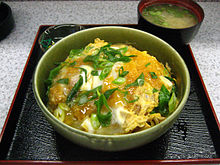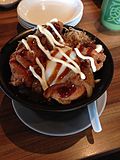Donburi: Difference between revisions
Added {{No footnotes}} tag |
→Varieties of donburi: move kanji / hiragana to prose using Nihongo template for cleaner headers |
||
| Line 11: | Line 11: | ||
Traditional Japanese ''donburi'' include the following: |
Traditional Japanese ''donburi'' include the following: |
||
===''Gyūdon'' |
===''Gyūdon''=== |
||
{{Main|Gyūdon}} |
{{Main|Gyūdon}} |
||
[[File:Gyudon by jetalone in Higashi-Ginza, Tokyo.jpg|thumb|''Gyūdon'' beef bowl]] |
[[File:Gyudon by jetalone in Higashi-Ginza, Tokyo.jpg|thumb|''Gyūdon'' beef bowl]] |
||
''Gyūdon'' |
{{Nihongo|''Gyūdon''|{{linktext|牛丼}}|extra=literally 'beef bowl'}}, is a Japanese dish consisting of a bowl of rice topped with beef and onion simmered in a mildly sweet sauce flavored with ''dashi'' (fish and seaweed stock), soy sauce and ''mirin'' (sweet rice wine). It also often includes [[shirataki noodles]], and is sometimes topped with a raw egg or a soft poached egg (''onsen tamago''). |
||
===''Butadon'' |
===''Butadon''=== |
||
"''Buta''" means pork. ''Butadon'' is a dish made with pork instead of beef in a mildly sweet sauce. ''Butadon'' originated in [[Hokkaido]] but is now enjoyed all over Japan.<ref name="auto">[http://wasa-bi.com/topics/332] {{dead link|date=August 2019}}</ref> |
{{Nihongo|"''Buta''"|{{linktext|豚|丼}}}} means pork. ''Butadon'' is a dish made with pork instead of beef in a mildly sweet sauce. ''Butadon'' originated in [[Hokkaido]] but is now enjoyed all over Japan.<ref name="auto">[http://wasa-bi.com/topics/332] {{dead link|date=August 2019}}</ref> |
||
==={{anchor|Tendon}}Tendon |
==={{anchor|Tendon}}Tendon=== |
||
{{redirect2|Tendon (Japanese cuisine)|Ten don|tendon meat in Asian cuisines|Tendon as food|other uses|Tendon (disambiguation)}} |
{{redirect2|Tendon (Japanese cuisine)|Ten don|tendon meat in Asian cuisines|Tendon as food|other uses|Tendon (disambiguation)}} |
||
[[File:Tendon in Tokyo.jpg|thumb|''Tendon'']] |
[[File:Tendon in Tokyo.jpg|thumb|''Tendon'']] |
||
{{Nihongo|Tendon|{{linktext|天|丼}}}} consists of ''[[tempura]]'' on a bowl of rice. The name "tendon" is an abbreviation of {{Nihongo|''tempura''|天ぷら {{lang|en|or}} 天麩羅}} and {{Nihongo|''donburi''|丼}}. |
|||
===''Tentamadon'' |
===''Tentamadon''=== |
||
{{Nihongo|''Tentamadon''|{{linktext|天|玉|丼}}}} consists of tempura which is simmered with beaten egg and topped on rice. |
|||
===''Unadon'' |
===''Unadon''=== |
||
{{Main|Unadon}} |
{{Main|Unadon}} |
||
[[File:Unadon1.jpg|thumb|''Unadon'']] |
[[File:Unadon1.jpg|thumb|''Unadon'']] |
||
''Unadon'' |
{{Nihongo|''Unadon''|{{linktext|鰻|丼}}|extra=an abbreviation for unagi + donburi, "eel bowl"}} is a dish originating in Japan. It consists of a ''donburi'' type large bowl filled with steamed white rice, and topped with fillets of eel (unagi) grilled in a style known as kabayaki, similar to teriyaki. The fillets are glazed with a sweetened soy-based sauce, called ''tare'' and caramelized, preferably over charcoal fire. The fillets are not flayed, and the grayish skin side is placed faced down. ''Una-don'' was the first type of ''donburi'' rice dish, invented in the late [[Edo period]], during the [[Bunka]] era (1804–1818) |
||
===''Tamagodon'' |
===''Tamagodon''=== |
||
{{Nihongo|''Tamagodon''|{{linktext|玉子|丼}}}} consists of a [[scrambled egg]] mixed with sweet ''donburi'' sauce on rice. |
|||
===''Oyakodon'' |
===''Oyakodon''=== |
||
{{Main|Oyakodon}} |
{{Main|Oyakodon}} |
||
[[File:Oyakodon 003.jpg|thumb|''Oyakodon'']] |
[[File:Oyakodon 003.jpg|thumb|''Oyakodon'']] |
||
[[simmering|Simmered]] [[chicken]], [[egg]], and sliced [[scallion]] served on top of a large bowl of rice. The chicken is also sometimes replaced with [[beef]] or [[pork]] in a variation referred to as {{nihongo|''Tanindon''|他人丼}}. |
{{Nihongo|''Oyakodon''|{{linktext|親子|丼}}}} consists of [[simmering|Simmered]] [[chicken]], [[egg]], and sliced [[scallion]] served on top of a large bowl of rice. The chicken is also sometimes replaced with [[beef]] or [[pork]] in a variation referred to as {{nihongo|''Tanindon''|{{linktext|他人}}丼}}. |
||
===''Katsudon'' |
===''Katsudon''=== |
||
{{Main|Katsudon}} |
{{Main|Katsudon}} |
||
[[File:Katsudon_01.jpg|thumb|''Katsudon'']] |
[[File:Katsudon_01.jpg|thumb|''Katsudon'']] |
||
{{Nihongo|''Katsudon''|{{linktext|カツ|丼}}}} consists of breaded deep-fried pork cutlets (''[[tonkatsu]]'') and onion are simmered and binding by beaten egg, then topped on rice. There are some regional variations in Japan. |
|||
===''Sōsukatsudon'' |
===''Sōsukatsudon''=== |
||
Sōsukatsudon is similar to Katsudon, but with sliced cabbage and sweet-salty sauce instead of egg.<ref name="auto"/> |
{{Nihongo|''Sōsukatsudon''|{{linktext|ソース|カツ|丼}}}} is similar to Katsudon, but with sliced cabbage and sweet-salty sauce instead of egg.<ref name="auto"/> |
||
===''Konohadon'' |
===''Konohadon''=== |
||
{{Nihongo|''Konohadon''|{{linktext|木の葉|丼}}}} is similar to ''oyakodon'', but using thin sliced [[kamaboko]] pieces instead of chicken meat. Popular in Kansai area. |
|||
==={{anchor|Karēdon}} ''Karēdon'' |
==={{anchor|Karēdon}} ''Karēdon''=== |
||
{{Nihongo|''Karēdon''|{{linktext|カレー|丼}}}} consists of thickened curry flavored ''[[dashi]]'' on rice. It was derived from curry ''[[udon]]'' or curry ''nanban'' (a ''soba'' dish). Sold at ''soba/udon'' restaurants. |
|||
===''Tekkadon'' |
===''Tekkadon''=== |
||
{{Main|Tekkadon}} |
{{Main|Tekkadon}} |
||
{{Nihongo|''Tekkadon''|{{linktext|鉄|火|丼}}}} consists of thinly-sliced raw [[tuna]] on rice. Spicy tekkadon is made with what can be a mix of spicy ingredients, a spicy orange sauce, or both (usually incorporates spring onions). |
|||
===''Hokkaidon'' |
===''Hokkaidon''=== |
||
{{Nihongo|''Hokkaidon''|{{linktext|北海|丼}}}} consists of thinly-sliced raw salmon over rice. |
|||
===''Negitorodon'' |
===''Negitorodon''=== |
||
{{Nihongo|''Negitorodon''|{{linktext|ネギ}}トロ丼}} consists of diced ''[[List of sushi and sashimi ingredients#Seafood|toro]]'' (fatty tuna) and [[Allium fistulosum|negi]] (spring onions) on rice. |
|||
===''Ikuradon'' |
===''Ikuradon''=== |
||
{{Nihongo|''Ikuradon''|いくら丼}} is seasoned ''ikura'' (salmon roe) on rice. |
|||
==={{anchor|Kaisendon}}''Kaisendon'' |
==={{anchor|Kaisendon}}''Kaisendon''=== |
||
[[File:Seafood Donburi at Tsukiji fish market.jpg|thumb|right|An elaborate ''kaisendon'' at [[Tsukiji fish market]]]] |
[[File:Seafood Donburi at Tsukiji fish market.jpg|thumb|right|An elaborate ''kaisendon'' at [[Tsukiji fish market]]]] |
||
{{Nihongo|''Kaisendon''|{{linktext|海鮮|丼}}}} consists of thinly-sliced [[sashimi]] on rice. Fish roe may also be included. |
|||
===''Tenshindon'' or ''Tenshin-han'' |
===''Tenshindon'' or ''Tenshin-han''=== |
||
{{Main|Tenshindon}} |
{{Main|Tenshindon}} |
||
{{Nihongo|''Tenshindon'' or ''Tenshin-han''|{{linktext|天津|丼}} / 天津{{linktext|飯}}}} is a Chinese-Japanese specialty, consisting of a crabmeat [[omelet]] on rice; this dish is named for the city of [[Tianjin]]. |
|||
===''Chūkadon'' |
===''Chūkadon''=== |
||
{{Main|Chūkadon}} |
{{Main|Chūkadon}} |
||
{{Nihongo|''Chūkadon''|{{linktext|中華|丼}}|extra=literally "[[Names of China|Chinese]] rice bowl"}} consists of a bowl of rice with stir-fried vegetables, onions, mushrooms, and thin slices of meat on top. This dish is similar to [[Chop suey]], and is sold at inexpensive [[Japanese Chinese cuisine|Chinese restaurants in Japan]]. |
|||
==Gallery== |
==Gallery== |
||
Revision as of 01:15, 11 September 2019
This article includes a list of references, related reading, or external links, but its sources remain unclear because it lacks inline citations. (August 2019) |

Donburi (丼, literally "bowl", also abbreviated to "don" as a suffix, less commonly spelled "domburi") is a Japanese "rice bowl dish" consisting of fish, meat, vegetables or other ingredients simmered together and served over rice. Donburi meals are served in oversized rice bowls also called donburi. When need to distinguish, the bowl is called donburi-bachi (丼鉢) and the dish is called donburi-mono (丼物). Donburi are sometimes called "sweetened" or "savory stews on rice".
The simmering sauce varies according to season, ingredients, region, and taste. A typical sauce might consist of dashi flavored with soy sauce and mirin. Proportions vary, but there is normally three to four times as much dashi as soy sauce and mirin. For oyakodon, Tsuji (1980) recommends dashi flavored with light soy sauce, dark soy sauce, and sugar. For gyūdon, Tsuji recommends water flavored with dark soy sauce and mirin.
Donburi can be made from almost any ingredients, including leftovers.
Varieties of donburi
Traditional Japanese donburi include the following:
Gyūdon

Gyūdon (牛丼, literally 'beef bowl'), is a Japanese dish consisting of a bowl of rice topped with beef and onion simmered in a mildly sweet sauce flavored with dashi (fish and seaweed stock), soy sauce and mirin (sweet rice wine). It also often includes shirataki noodles, and is sometimes topped with a raw egg or a soft poached egg (onsen tamago).
Butadon
"Buta" (豚丼) means pork. Butadon is a dish made with pork instead of beef in a mildly sweet sauce. Butadon originated in Hokkaido but is now enjoyed all over Japan.[1]
Tendon

Tendon (天丼) consists of tempura on a bowl of rice. The name "tendon" is an abbreviation of tempura (天ぷら or 天麩羅) and donburi (丼).
Tentamadon
Tentamadon (天玉丼) consists of tempura which is simmered with beaten egg and topped on rice.
Unadon

Unadon (鰻丼, an abbreviation for unagi + donburi, "eel bowl") is a dish originating in Japan. It consists of a donburi type large bowl filled with steamed white rice, and topped with fillets of eel (unagi) grilled in a style known as kabayaki, similar to teriyaki. The fillets are glazed with a sweetened soy-based sauce, called tare and caramelized, preferably over charcoal fire. The fillets are not flayed, and the grayish skin side is placed faced down. Una-don was the first type of donburi rice dish, invented in the late Edo period, during the Bunka era (1804–1818)
Tamagodon
Tamagodon (玉子丼) consists of a scrambled egg mixed with sweet donburi sauce on rice.
Oyakodon

Oyakodon (親子丼) consists of Simmered chicken, egg, and sliced scallion served on top of a large bowl of rice. The chicken is also sometimes replaced with beef or pork in a variation referred to as Tanindon (他人丼).
Katsudon

Katsudon (カツ丼) consists of breaded deep-fried pork cutlets (tonkatsu) and onion are simmered and binding by beaten egg, then topped on rice. There are some regional variations in Japan.
Sōsukatsudon
Sōsukatsudon (ソースカツ丼) is similar to Katsudon, but with sliced cabbage and sweet-salty sauce instead of egg.[1]
Konohadon
Konohadon (木の葉丼) is similar to oyakodon, but using thin sliced kamaboko pieces instead of chicken meat. Popular in Kansai area.
Karēdon
Karēdon (カレー丼) consists of thickened curry flavored dashi on rice. It was derived from curry udon or curry nanban (a soba dish). Sold at soba/udon restaurants.
Tekkadon
Tekkadon (鉄火丼) consists of thinly-sliced raw tuna on rice. Spicy tekkadon is made with what can be a mix of spicy ingredients, a spicy orange sauce, or both (usually incorporates spring onions).
Hokkaidon
Hokkaidon (北海丼) consists of thinly-sliced raw salmon over rice.
Negitorodon
Negitorodon (ネギトロ丼) consists of diced toro (fatty tuna) and negi (spring onions) on rice.
Ikuradon
Ikuradon (いくら丼) is seasoned ikura (salmon roe) on rice.
Kaisendon

Kaisendon (海鮮丼) consists of thinly-sliced sashimi on rice. Fish roe may also be included.
Tenshindon or Tenshin-han
Tenshindon or Tenshin-han (天津丼 / 天津飯) is a Chinese-Japanese specialty, consisting of a crabmeat omelet on rice; this dish is named for the city of Tianjin.
Chūkadon
Chūkadon (中華丼, literally "Chinese rice bowl") consists of a bowl of rice with stir-fried vegetables, onions, mushrooms, and thin slices of meat on top. This dish is similar to Chop suey, and is sold at inexpensive Chinese restaurants in Japan.
Gallery
-
Pork sukiyakidon
-
Kaisendon
-
A bowl of Japanese rice topped with karaage chicken, soft-boiled egg, vegetables and topped with condiments
See also
- Gaifan - similar Chinese dish
- Loco moco - similar Hawaiian dish
- Japanese cuisine
- List of Japanese dishes
References
Bibliography
- Tsuji, Shizuo (1980). Japanese cooking: A simple art. New York: Kodansha International/USA. ISBN 0-87011-399-2.



